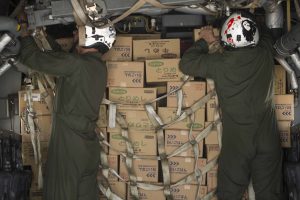On January 16, Japan’s Defense Minister Kihara Minoru announced that the United States Forces Japan (USFJ) will participate in relief operations by beginning aid deliveries to quake-hit areas in central Japan’s Noto Peninsula on January 17, at the formal request of the Defense Ministry. The Japan Self-Defense Forces (JSDF or SDF) are currently carrying out relief operations.
Two UH-60 Black Hawk helicopters from U.S. Army Aviation Battalion Japan will join the relief efforts, USFJ also announced in a statement on the same day.
This is the first time that the U.S. military will provide assistance to an earthquake-affected area in Japan since 2016 when strong quakes struck southwestern Japan’s Kumamoto Prefecture.
“The SDF is currently making every effort to transport secondary evacuees” away from the affected areas, Kihara said at a press conference on January 16. “But due to the significant increase in the SDF’s mission, we’ve requested support from the U.S. Forces in Japan to continue transporting relief supplies that the SDF has been carrying out without a hitch.”
Kihara said U.S. military will be based at the Japan Air Self-Defense Force Komatsu Air Base in Ishikawa Prefecture, and will be transporting relief supplies to Noto Airport using two UH-60 Black Hawks.
Kihara also said that the SDF are currently doing their best to respond to the earthquake, with about 14,000 personnel engaged in relief work, including around 6,800 personnel on the ground in the affected area. In addition, he said that 50 aircraft and 10 ships are conducting operations in the earthquake zone.
The announcements came more than two weeks after the deadly earthquake struck off the Noto Peninsula on New Year’s Day. Until now, Tokyo hasn’t accepted a two-week-old offer of U.S. military aid for the disaster-stricken areas.
On January 4, U.S. Department of Defense press secretary Major General Patrick Ryder said at a press conference in Washington that “we remain in close communication with the government of Japan, and we do stand ready to aid in any way that would be most helpful to Japan.”
On January 5, U.S. Ambassador to Japan Rahm Emanuel also wrote on X, formerly Twitter, “A true friend shows up when times are good but more importantly when times are challenging. The [U.S.] is here to support our friend and ally in its earthquake response. Military logistical support, food, and other supplies are being readied. We will stand with Japan every day forward and stand by their side on their path to recovery and rebuilding.”
Why was there such a delay in accepting the USFJ offer of assistance?
Japanese government agencies are still busy responding to the disaster at hand. Even if foreign relief forces arrive, there is little room to formulate an effective international cooperative framework for cooperation. Additionally, the port and roads on the peninsula are severely damaged, making it difficult to approach.
Asked about why the government has requested assistance this time from the USFJ, Kihara said the U.S. military already has transportation means such as rotary-wing aircraft in Japan, and has self-contained transportation capabilities that can be used quickly to support disaster victims.
In addition, he pointed out that the JSDF and USFJ work closely with each other on a regular basis, paving the way for coordination needed in joint disaster relief operations. Thus, Japan has requested exceptional transportation support from the USFJ.
On January 5, Japan’s Foreign Minister Kamikawa Yoko said at a press conference that although Japan had received offers of sympathy and support from more than 100 countries, regions, organizations, and individuals, the government currently has a policy of not accepting material or human aid from anyone other than the United States.
Many experts such as emergency management specialist Leo Bosner have pointed out Tokyo needs a Japanese version of the Federal Emergency Management Agency (FEMA) in the United States to coordinate government-wide planning and response for a full range of disasters. Creating such a dedicated body would also enable Japan to accept offers of help from foreign countries and international organizations instead of turning them away.
In Japan, the U.S. military’s large-scale disaster relief efforts began in 1995 with the Great Hanshin Earthquake. It helped provide water and blankets and set up tents.
During the Great East Japan Earthquake in 2011, the USFJ carried out a wide range of the relief mission, known as Operation Tomodachi, jointly with the JSDF. “Tomodachi” means friends in Japanese.

































